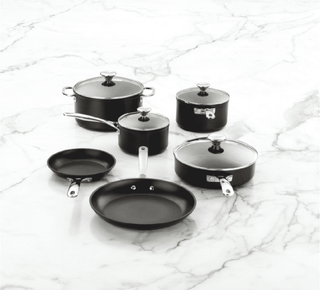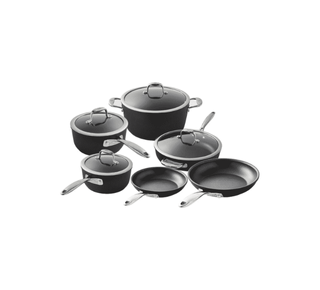Is nonstick cookware safe? Here’s what you need to know.
2025 Aug 28th
Is nonstick cookware safe? Here’s what you need to know about polytetrafluoroethylene and the other materials used for manufacturing nonstick cookware.
Words such as perfluorooctanoic acid and polymer fume fever aren’t good when it comes to cooking dinner for the family. The host of acronyms are enough to make anyone want to take a second look at what is in their nonstick cookware. GenX, PFOS, Teflon and PFOA sound like things meant for a spaceship, not a frying pan.
What you need to know is safety first. Before buying nonstick cookware, you should ask yourself:
- How good is this technology vs the health and safety of you and your family?
- How long does it last without any cooking or health issues?
- How much does it cost?
- Is it better than other materials when it comes to cookware?
At Williams Food Equipment, we provide professional-grade equipment for chefs and home cooks, including both non-stick and traditional cookware. Here’s what you need to know about non-stick materials.
Related: 12 Must-have Kitchen Accessories

What is Nonstick Cookware?
Nonstick cookware is what the name indicates: a product that allows foods such as eggs not to adhere to the pan. The invention was an accident. In 1938, DuPont was in the process of developing a new refrigerant. Instead, a white, waxy, super slippery, and water-resistant substance appeared. Water repellent clothing was the first implementation of PTFE. Then, 20 years down the road, PTFE was placed on cookware.
PFOA-free and other substances have now been in development. Cooking with nonstick now doesn’t have to include the buzzword ‘Teflon” anymore. PTFE is completely safe, but as newer compounds are created, the slippery world of cooking continues to grow!
The Dangers of Nonstick Cookware Overheating
The primary danger of fluoropolymers overheating is degradation at 500 degrees. At this high temperature, toxic fumes could be released. This might result in illness in humans. The main “ingredient” in this negative reaction is Perfluorooctanoic acid (PFOA). In cookware, this chemical is burned off at production. There is little to no PFOA in your nonstick cookware.
What Happens When Nonstick Cookware Starts Flaking Off?
Perfluorocarbon resin is not a dangerous substance when consumed in tiny bits from an old nonstick pan. Avoiding endangering your cookware is always paramount. Like any appliance, proper maintenance and usage will keep everything in proper working order when cooking and consuming. Flaking can be curtailed by lower heats, appropriate cooking utensils, and cleaning correctly.
What happens when flaking occurs in your nonstick cookware? Well, not much at first. A few little marks and specks can take place. Only use silicone or approved spatulas and spoons for your nonstick cookware. Clean it well with a soft sponge and detergent, then add a bit of oil heated into the cookware once dried to further prevent it from flaking.

Flaking isn’t a tragedy, but prevention and/or a new purchase could aid in your culinary skills. A flaky pan will not hold heat evenly, nor will it be easy to flip proteins due to the lack of smoothness. There are sprays out there online that claim to fix your damaged nonstick cookware but purchasing quality nonstick cookware will save you the hassle in the long run. A Zwilling J.A. Henckels - Forte 10pc TI-X 5 Layer Nonstick Cookware Set will safeguard quality cooking using these pans and cash savings over a longer span then buying less reputable nonstick cookware.
Tips You Need To Know Before Cooking
- Never broil with nonstick cookware! Broiling is way hotter than the 500 degrees your nonstick pots and pans can withstand. Make sure to keep this type of cookware for stovetop use only.
- Never preheat a nonstick pan. Preheating without liquid, fat, or food inside will bring the pan up to temperature way too quick, potentially resulting in a temperature at or above 500 degrees. Plus, the food will be cooked at an uneven rate.
- Always use the correct utensils. Wooden, silicone, and nylon are all suitable for nonstick cookware. Being gentle is an attribute of the culinary arts. Save your pots and pans by using almost anything but metal.
- Create a Zen-like kitchen with proper airflow. Turn on a fan or open a window. This goes for nonstick, and all aspects of cooking. Always be safe regarding air and fire.
- Using some butter, oil, or another fat is advantageous to the pan and to the palate. Nonstick is already slippery, but adding more glide helps even cooking, more moisture, and more flavor!
- Seriously, buy quality equipment. There are “nonstick” pots and pans at the Dollar Store…Don’t fall for “The Big Red” this or “Diamond Steel” that pan as seen on tv, as they can be the most dangerous of all cookware due to their lack of quality.
What Are The Different Alternatives to Nonstick Cookware?
As technology grows, so too does the craftsmanship of cookware. Nonstick is valued for just that, not sticking. PTFE is some of the best and safest. If you wish to explore some of the other alternatives to PTFE, ceramic might be the one pan or pot for you!
Ceramic sounds and looks pretty. It works just as well as all other nonstick cookware out there. Ceramic cookware is really a metal pot or pan dressed in silicone to create its glossy appearance. The difference in this coating in comparison to other nonstick cookware is that silicone ceramic can withstand up to 800. Like anything else, quality counts!
Enameled coated cast iron is another alternative to nonstick coated fry pans. These pans are heavy, hold heat, and stay slippery.
One of the oldest in technology and craftsmanship is copper. Stainless steel has been around for quite some time as well. These two have blended to fashion some of the best nonstick cookware in the world.
What Cookware Should I Buy?
In 2015, PFOA was taken out of cookware production. So that fear can be laid to rest. PTFE is safe according to Canada and USA reports. Of course, stabbing your supermarket nonstick pan with a fork while the pan has been on the burner for half an hour repeatedly wouldn’t be an ideal eating situation. In essence, it would take a lot of PTFE non-stick shavings ingested for a long while to employ any health concerns.
Again, quality counts. Purchasing quality cookware will ensure a happy, healthy, and durable cooking experience. Buying infomercial cookware will be fine for a month.
At Williams Food Equipment, we strive for excellence. That’s why our line of cookware includes top products from some of the best companies in the culinary world, including Zwilling J.A. Henckels, Le Creuset, Demeyere, Lodge, Mauviel, and so many more. We are very proud to partner with them to bring you the best in nonstick and traditional cookware. All other accessories, tools and equipment are a click away from being shipped to you anywhere in Canada!


